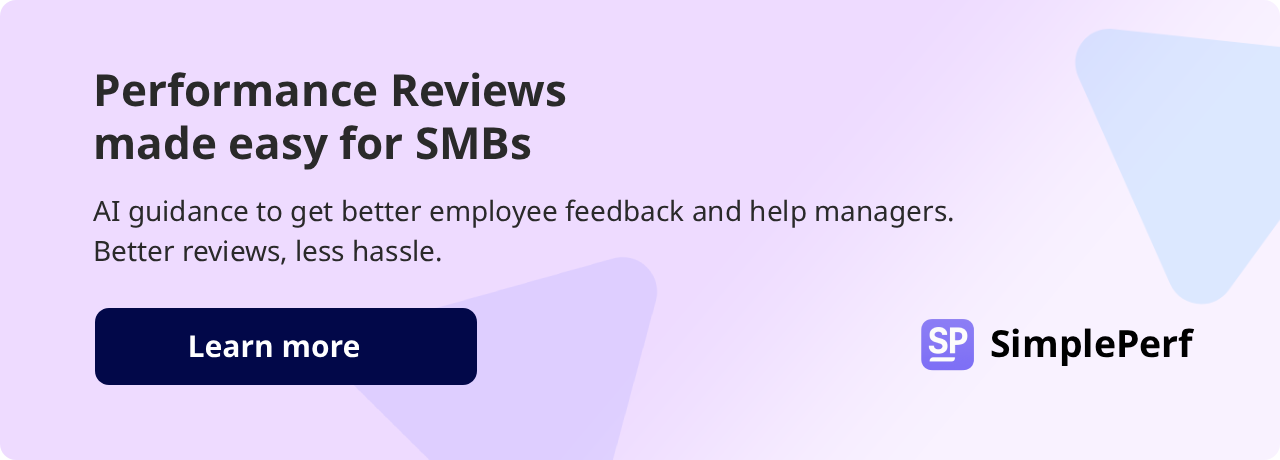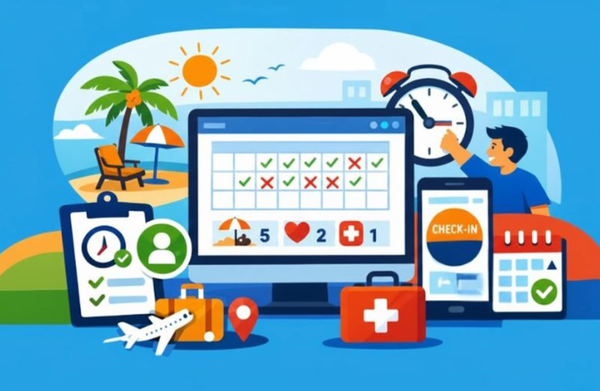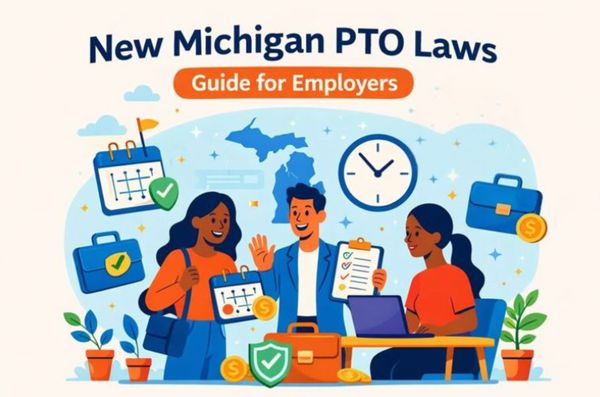Employee performance goals: Examples you can use right now
Struggling to set performance goals? Discover practical examples you can use right now to increase employee satisfaction and reach business goals with BuddiesHR.

Setting performance goals for employees can be challenging - especially if you’re not sure where to start. Their importance for your business obviously hasn’t escaped your notice because you’re here, looking up employee performance goals - and that’s a good thing.
In this guide, you’ll find examples for setting OKRs or Key Performance Indicators (KPIs). You can use this list to mix and match performance goals until you feel satisfied that these goals will support your key business objectives. Not only that, but you’ll discover how performance review tools can automate this process and give you real-time performance data when you need it most. If it’s time to get everyone on board, then let’s get it done!

Quick Answer
Employee performance goals should be clear, measurable, and achievable so they align with company objectives while supporting professional growth. Use frameworks like SMART or the goal pyramid to keep goals structured, and performance software like BuddiesHR to track progress in real time.
Table of Contents
- What should employee performance goals look like?
- Basic performance objective parameters
- Performance goal examples
- How HR software can help manage goal setting and performance reviews
- Conclusion
What should employee performance goals look like?
Employee performance goals should be specific and measurable goals that help employees contribute towards organizational results, but also pursue their professional development goals and get job satisfaction.
Goal Pyramid Methodology
Suggests that every role in your business must produce valuable results for your company, and setting goals helps you work out which roles do that, and which roles don’t. It works as follows:
- Top focus: The company’s strategic goals
- Middle focus: Team objectives that support the broader strategic initiatives
- Bottom focus: Individual contributions tied to team and company objectives
Stay focused on a set of goals that will apply to different roles, regardless of who actually fills the position - this is a best practice for setting performance goals. This exercise is about making all the individual parts (roles) fit together to create a big picture (business success).
The goal pyramid draws from Maslow’s hierarchy of needs and has been successfully used to improve performance by understanding what drives people’s behaviors towards achievement.
SMART goal setting examples
The SMART framework - Specific, Measurable, Achievable, Relevant, Time-bound is the most reliable way to set out performance expectations. Here are five SMART performance goals examples for employees:
Improved communication:
Enhance team communication skills by providing detailed and constructive feedback at weekly team meetings. Improvement to be measured by quarterly peer reviews. This goal evaluates:
- Communication skills
- Presentation skills
Expand professional sales network:
Attend two industry-related seminars or conferences per quarter, and join a mentorship program to practice strengthening your professional network, thereby increasing potential leads. This goal evaluates:
- Relationship-building skills
- Sales lead generation skills
Practice critical thinking in decision-making:
Improve critical thinking by providing six innovative solutions to team challenges during the next six months. Solutions to be evaluated with a manager and peer review. This goal evaluates:
- Innovative thinking
- Leadership skills
Basic performance objective parameters
Along with the Goal Pyramid and SMART framework, SMBs and startups can use five broad-based performance parameters to help with setting performance goals. They apply to most industries, job roles, and team objectives.
- Quality - Measurable goals that focus on the standards you’ve set in your business, ensuring they’re met, and even exceeded.
- Speed - Goals that focus on how quickly a process is completed, reducing task complexity, and easier decision making.
- Dependability - Setting accountable measures that ensure deadlines, targets, team goals, and strategic initiatives are met.
- Flexibility - Relevant goals that increase capacity to learn new skills and work on more complex tasks for career growth.
- Cost - Goals that keep the use of resources to an efficient level, supporting business success.
Goal writing golden rule: The objective you set must be in the employee’s direct control and ability to reach it. This ensures that all objectives are fair, achievable, and that individual contributions are measurable. An example of this:
By the end of September, increase customer satisfaction ratings by 10% by resolving open support tickets promptly and escalating them to the next authority level within 12 hours.
Performance goal examples
Leadership skills
- Practice using the GROW coaching model by coaching two junior staff members on new processes for the 3rd quarter. To be evaluated by a one-on-one assessment.
- Demonstrate decision-making by leading the broader team in a new project during the fourth quarter. The outcome to be evaluated by meeting targets and 360 reviews.
- Apply the goal pyramid methodology to break down high-level company objectives into team goals by October.
- Coordinate daily check-ins and assign specific tasks to team members to achieve our overall mission of a 9.5 customer satisfaction rating.
Professional development
- Attend five industry conferences and present the new information to the management team at the company's annual strategy meeting in the fourth quarter. Complete a self-assessment on your presentation.
- Take a certification course in the third quarter to improve your technical skills and pass the assessment by a minimum of 80%.
- Enroll in a post-graduate program for personal development, and report on the three areas you will improve in the team as a result of this program by Q1 in 2026.
Communication and soft skills
- Attend a communication skills workshop in Q1 and complete a formal assessment showing marked improvement in writing, verbal, and non-verbal communication. Report to be submitted by the facilitator in Q1.
- Participate in two sales role plays per month with the sales manager to improve deal-closing skills. Close rate to improve by 15% in Q2 as a result of new skills.
- Implement two key values to promote the organizational culture, which are to be assigned by the team manager. Receive positive feedback through Clappy Kudos.
Innovation and problem-solving
- Arrange three meetings with team members from different departments to discuss in Q4 how industry trends are influencing the business, and submit a report on the suggested solutions by the end of the quarter.
- Submit a researched report on how to reward employees for their individual performance during complex projects. Success is to be measured by an employee engagement survey.
- Boost customer retention by 30% per annum by implementing the rewards program and offering highly personalized services to niche customers.
Sales performance goals
- Increase individual sales revenue by 15% over the next quarter by selling value-added products to core products, and pursuing three qualified leads a month.
- Raise conversion rates from prospect to customer by 10% in the next two months by developing stronger pitches focused on the benefits of our products.
- Increase quarterly sales by 25% through target outreach campaigns and driving the sales funnel. Evaluation will be through quarterly targets.
Operational efficiencies
- Reduce order processing by 15% over the next month using workflow automation and improved approval turnaround times.
- Decrease product defects by 8% in three months by introducing one additional checkpoint at the assembly line.
- Reduced missed project deadlines by 40% over the next quarter by using project management tools and feedback systems.

How HR software can help manage goal setting and performance reviews
Setting performance goals on paper is only half the job - the other half is managing progress and tracking data that actually matters. This can become a mammoth task, but it doesn’t have to be. With software like BuddiesHR, you get the following benefits:
- Centralized goal setting - Forget about endless spreadsheets that don’t give you streamlined information.
- Real-time goal tracking data - Instead of waiting until everyone submits a report, see real-time progress for the entire team or company.
- AI-powered insights and summaries - Even if you have sophisticated spreadsheets, what does all the information mean? BuddiesHR AI-driven technology will interpret the data for you and give you valuable summaries to improve employee performance.
- Automated performance review process - Don’t let HR spend their time arranging meetings and collecting documents. The system will send reminders, notifications, and 360 reviews to raters.
- First-time managers can set up and run the entire process within hours - it’s that easy to use, and specifically designed to provide small teams with powerful tools without the cost or the complexity of other HRIS platforms.
Set up goals and start tracking them today with BuddiesHR
Conclusion
The right mix of SMART goals, team objectives, and development goals ensures that business objectives are met, while increasing employee satisfaction. By setting goals in this way, you can:
- Drive performance intelligently.
- Help employees to gain the correct skills and develop professionally.
- Make employees accountable for their contribution to the company’s success.
- Create a sense of achievement for the entire company with transparent progress reports.
- Create a culture of excellence by clearly outlining expectations.
By using performance management software to manage the entire process, you can empower yourself to have meaningful conversations that lead to performance improvements and success for everyone.
👉Set smart goals today with BuddieHR, and watch your team (and business) thrive!
Frequently Asked Questions
1. How often should performance goals be reviewed?
Performance reviews should be conducted at least quarterly to ensure progress, make changes, and keep goals aligned with business needs.
2. Can small companies run performance reviews?
Absolutely, you are never too small to set goals and run performance reviews - they will establish a solid foundation for future growth.
3. How many performance goals or OKRs should each role have?
It is better not to have more than five OKRs for one role; however, there is no hard-and-fast rule about it. Focus on the key outcomes the role must achieve, instead of the tasks that must be fulfilled when setting objectives.





